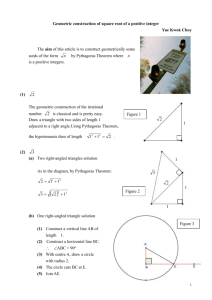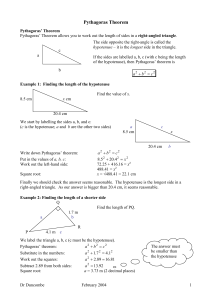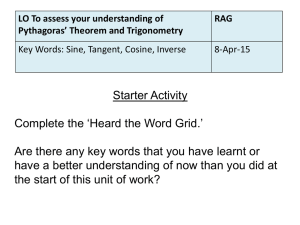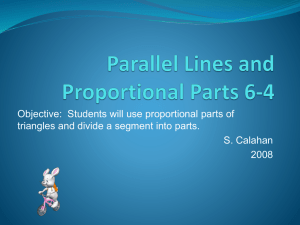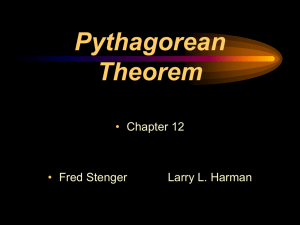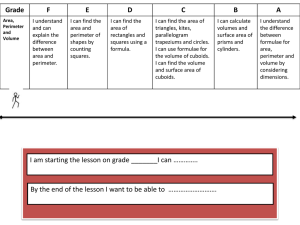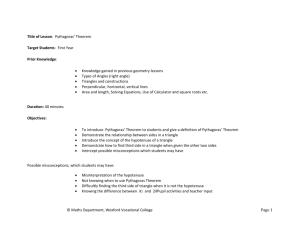to the animated example
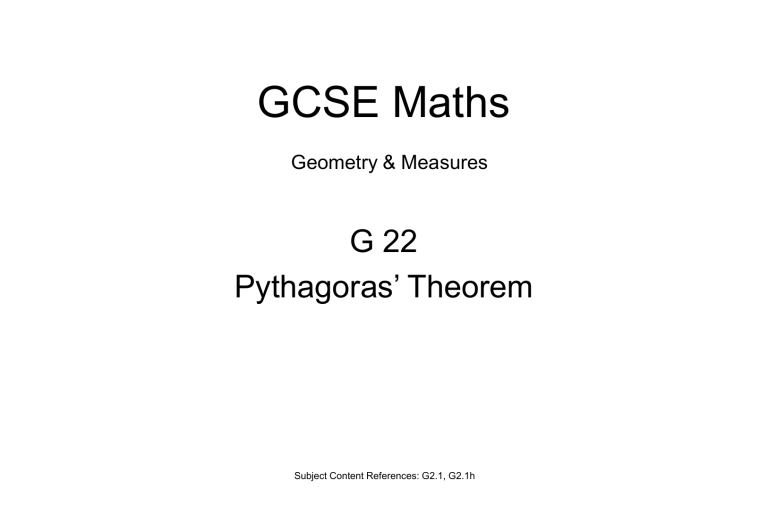
GCSE Maths
Geometry & Measures
G 22
Pythagoras’ Theorem
Subject Content References: G2.1, G2.1h
Pythagoras’ theorem states:
For any right-angled triangle , the area of the square on the hypotenuse is equal to the sum of the areas of the squares on the other two sides
Example
Let’s take a look at a right-angled triangle with sides 3 , 4 & 5 cm:
This side is 3 cm long, so the area of the square on this side is 9 cm 2
. . and this side is 4 cm long, so the area of the square on this side is 16 cm 2
9
16
25
The hypotenuse is 5 cm long, so the area of the square on the hypotenuse is 25 cm 2
As we can see,
9 + 16 = 25
In general, for any right-angled triangle of sides a, b & c, where c is the hypotenuse a 2 +b 2 = c 2 learn
Clearly, this works for a ‘3, 4, 5’ triangle, but does it work for all right angled triangles?
Example
Let’s have a look . . here’s a right-angled triangle: b c
I measured a, b and c and found: a = 5.8 cm, b = 2.9 cm and c = 6.5 cm
Theoretically (using Pythagoras’ theorem),
5.8
2 + 2.9
2 should be equal to
6.5
2 a 5.8
2 + 2.9
2 = 33.64 + 8.41 = 42.05
The actual value of 6.5
2 = 42.25
. . which is pretty close . . and my measuring may not have been accurate enough . .
Exercise 1
In order to verify Pythagoras’ theorem for ourselves, draw two or three right angled triangles on squared paper and measure their sides as accurately as possible. To check, use the formula a 2 + b 2 = c 2 for each triangle drawn
Example
Since for any right-angled triangle, a 2 + b 2 = c 2 (Pythagoras) we can say a 2 = c 2 - b 2
(subtracting b 2 from both sides), and b 2 = c 2 - a 2
(subtracting a 2 from both sides)
This is really important, because it means that if we know the lengths of any two sides of a right-angled triangle, we can calculate the length of the third side . .
learn
Examples
1) A right-angled triangle ABC has sides a = 8cm and b = 4cm. Calculate the length of side c to 1 decimal place:
A b c
If a 2 + b 2 = c 2 (Pythagoras) then 8 2 + 4 2 = c 2 so 64 + 16 = c 2
c 2 = 80
c = √80
c = 8.9cm (1 dp)
C a
B answer
A b
C c a
If a 2 + b 2 = c 2 (Pythagoras) then b 2 = c 2 - a 2
(subtracting a 2 from both sides to make b the subject of the equation) so b 2 = 11 2 - 8 2
b 2 = 121 - 64
b = √57
b = 7.5cm (1 dp) answer
B
Exercise 2
Using a right-angled triangle with sides a, b and c, where c is the hypotenuse, calculate (to 1 dp) the following:
1) a, when b = 7cm, c = 10cm
2) b, when c = 9m , a = 6m
3) c, when a = 7km, b = 6km
4) b, when c = 12m , a = 8m
5) c, when a = 3km, b = 2km
6) a, when b = 1.3cm, c = 5.1cm
7) c, when a = 3.8km, b = 4.5km
8) a, when b = 8.9cm, c = 13.4cm
Example: Examination question
A ladder of length 6m is leant up against the top of a vertical wall. It ’ s base is 2.7m away from the wall. Calculate the height of the wall to the nearest cm: h
Step 1: Draw the diagram
6m
Step 2: We need to show that we recognise this as a problem involving Pythagoras’ theorem, so state it:
In any right-angled triangle with sides a, b and c, where c is the hypotenuse, a 2 + b 2 = c 2 (Pythagoras)
2.7m
From the diagram, therefore, h 2 + 2.7
2 = 6 2
h 2 = 6 2 - 2.7
2
. . subtracting 2.7
2 from both sides
h 2 = 36 - 7.29 = 28.71
h = √28.71 = 5.36m answer
Exercise 3
1) Point A is due north of point B at a distance of 12 km. Point C is due east of point B at a distance of 7 km. Calculate the distance between point C and point A to the nearest metre.
2) The hypotenuse of a right-angled triangle measures 22.3 cm. Its height measures
15.4 cm. Calculate the length of the base of the triangle to the nearest millimetre.
3) Look at the following grid (divided into equal squares). If each square is of side 1 metre, calculate the distance a) between A & B and b) between C & D to the nearest cm:
A C a)
B b)
D
Pythagoras’ theorem can also be used to solve 3-D problems that usually involve more than one triangle . .
Example
Below is a cuboid of width 5.8 cm, length 8.6 cm and height 3.5 cm.
Calculate the length of the line BH to the nearest mm:
B
C
8.6 cm
F
G
A
D
5.8 cm
Step 1: In order to calculate the length of line BH, we need to know the length of line CH . .
. . because the right-angled triangle BCH will enable us to find BH using Pythagoras’ theorem
Step 2: Identify the right-angled triangle CGH . .
. . because the right-angled triangle CGH will enable us to find CH using Pythagoras’ theorem
E
3.5 cm
Step 3: Using Pythagoras’ theorem . .
(CH) 2 = 8.6
2 + 5.8
2
= 73.96 + 33.64
CH = √107.6 = 10.373 cm
H Step 4: Using Pythagoras’ theorem . .
(BH) 2 = 3.5
2 + 10.373
2
= 12.25 + 107.6
BH = √119.85 = 10.9 cm answer
Exercise 4
1) Below is drawn a cuboid shaped room of height 2.2 m, width 5.6 m and length 9.7 m. Calculate the distance BS to the nearest cm:
A B
D C
P Q
S R
2) This a cuboid shaped factory of height 14.5 m, width 30.6 m and length 72.7 m. Calculate the distance AY to the nearest cm:
A B
D C
W X
Z Y
